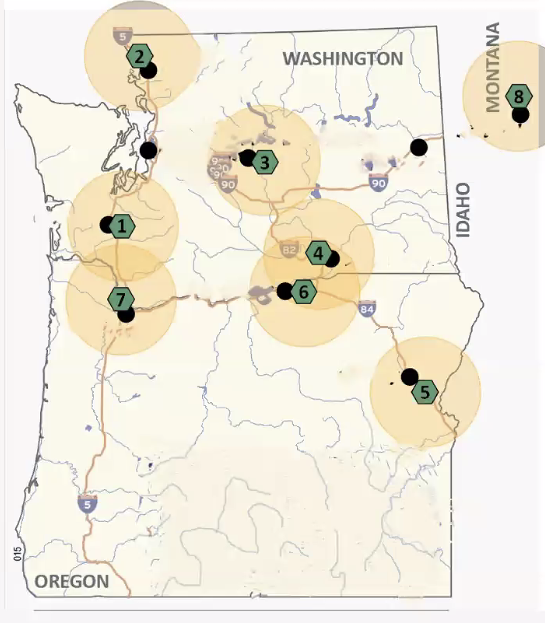By Nick Fitzmaurice
The Pacific Northwest Hydrogen Hub could be home to eight hydrogen production facilities. Image via Pacific Northwest Hydrogen Association.

In October, the Biden Administration announced $7 billion in awards to develop seven distinct “clean” hydrogen hubs across the US. These funds are part of the Infrastructure Investment and Jobs Act (IIJA). The regional hubs are the Mid-Atlantic, Appalachian, California, Gulf Coast, Heartland, Midwest, and Pacific Northwest. Last year, Gov. Greg Gianforte entered an agreement with the governors of North Dakota, Minnesota, and Wisconsin to be a part of the Heartland Hub, but when the grants were announced, North Dakota, South Dakota, and Minnesota were the only states included (though press releases state the hub may later expand into neighboring states such as eastern Montana). However, some of these federal funds are still likely to reach Montana through the Pacific Northwest Hub, tentatively including a project for western Montana’s St. Regis.
Producing hydrogen from water using electrolysis is an incredibly energy-intensive process. While clean hydrogen — hydrogen produced using only clean energy — is likely to be a part of the energy transition, it should only be used for the most challenging decarbonization sectors. These “hard to abate” sectors include industrial and commercial applications such as cement production, shipping, and aviation. While these industries may need to rely on clean hydrogen to decarbonize fully, they should do so only after alternatives are thoroughly considered. This use of hydrogen must be truly clean, with zero associated emissions throughout the fuel’s value chain.
Although touted as “clean,” not all of the hubs are truly slated to be so. Hydrogen is classified by a range of colors based on how it is produced. Included in these hydrogen hubs are blue, pink, and green hydrogen. Blue hydrogen is produced from fossil fuels where CO2 is captured and either stored or repurposed, and pink hydrogen is produced using nuclear power. These forms of hydrogen rely on expensive and unproven technologies. Green hydrogen is produced using 100% renewable energy for the electrolysis of water and is the only truly clean form of hydrogen production.
Four of these hubs plan to use blue hydrogen in part, including the Heartland Hub. The Pacific Northwest Hub intends to use green hydrogen from hydropower and other renewable energy sources. Unfortunately, very little information has been released by the U.S. Department of Energy regarding these proposals, and there are no publicly available plans for scaling up renewable energy generation to power these hubs.
It is important to keep an eye on these hydrogen hubs as they develop to ensure extensive federal funds are not wasted or put toward polluting hydrogen projects.
This article was published in the December 2023 issue of Down To Earth.

